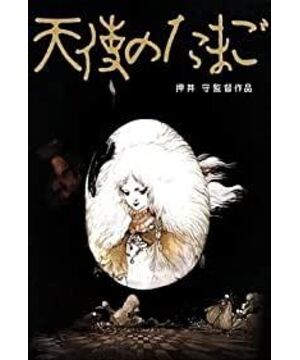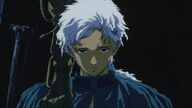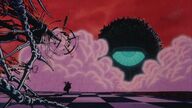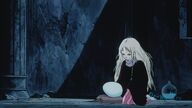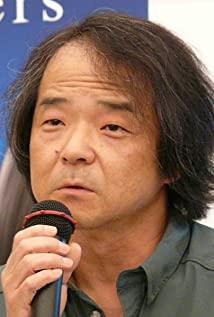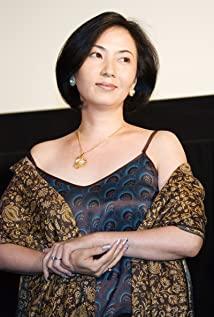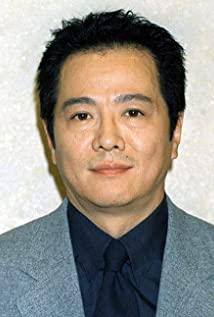Let's shuffle the order and start after the end of Angel's Egg. At the end of "Mobile Police Theatrical Edition 2", when Zhezhi said how phantom-like the city was, it was not out of pessimistic nihilism. In a sense, the phantom is more valuable than the so-called "real". The fictional lens of an animated film itself has the ability to reverse reality and fantasy. Reality and fantasy are no longer a binary opposition. The more illusory, the more real, and reality can be constructed in fantasy.
For me, the biggest and most remarkable project of "Mobile Police Theatrical Edition 2" is the reconstruction and exploration of the city. As the most famous city ever played in Japanese animation, does Tokyo still need to be rediscovered? People are so familiar with it, how can you show a new side of him in animation. Mamoru Oshii's answer is to put the whole of Tokyo in a state of emergency through an unusual story and let the camera desperately create obstacles to interpretation. The slow camera follows the characters to show the city itself, which is wider and more magnificent than the story itself. This familiar city is so unfamiliar. But the movie still feels that this is not enough, so at the climax of the rebellion, the machine guns and missiles destroy the city, and the city is better able to reshape itself in this state. This is done when vegetation captures. What missiles and explosives can destroy is the Phantom, and for the Phantom, destruction and creation are the same thing. So much so that the creator (destroyer) Zhe Zhi, risking the death penalty, has to live to see the city (phantom) he created. This is logic that can only be achieved in an animated shot.
This kind of thinking can also be seen in "Attack in the Shell 2", although the content of the two to be discussed is quite different. And this article does not intend to advance the timeline to 2004 to explore the movie that is more well-known to the world, but to go forward and reread "Angel's Egg" by Mamoru Oshii in 1985-Oshii Mamoru's later great films broke out of the shell. process, from potential to actual fulfillment of the Messianic moment. How on earth does a film with such a strong mysticism accomplish itself, and where is its real secret? Out of the author's habit, this article will try to refrain from mentioning the word director, and understand the film as the self-completion of the film.
Entering the film text, the narrative of "Angel's Egg" begins with a destructive prophecy, allowing the entire film to unfold in a sense of inevitability. At the beginning, a hand in the dark, hold it down, the sound of eggshells breaking. On the one hand, it predicts the fate that the "egg" will be broken, and the purpose of the film itself is to break the egg. The key is how to break it and when to break it. And we can think of the egg as being broken before the narrative begins, but then deliberately repaired and delivered to the teenage girl as the film begins. And the content (meaning) of the egg has been replaced (given) pre-existingly, whether or not the egg existed before, what existence is no longer important, because it has been replaced by a thing that can only refer to nothingness. This effectively ensures that the egg retains only the structural function of the film, a false core of the film that hides the true purpose of the film.
Why does a movie hide its true purpose? This question can be replaced with why the teenager's mission to break the egg has to be delayed again and again? (This reminds me of the classic question of why Hamlet delays revenge.) Breaking the egg is not actually the real purpose of the movie, the real purpose of the movie is when it shows its most sublime scenes. Looking back from the end of the film, the real purpose of the film is to create a world of mysticism that can be considered real in a completely fictional world of animation, and to allow a character to complete a full performance on this real stage. And the movie needs an excuse to cover up this real purpose, and try to prolong the narrative time of the movie, so that the movie can get more space and time to show itself.
Then, a lifted, unlaid, transparent egg appears in the shot, with a green embryo that a bird is forming inside. Then, the camera gave a close-up of the bird's eye, which quivered, new life about to break out of its shell. In the whole film, the existence of the bird is limited to sleep in the shell, and has no actual effect. Even though the boy brought up the image of the rescued bird, the rescue was not actually carried out. So why does the movie cut open another egg to show us what's inside? In fact, revealing what is hatching in the egg does not directly damage the egg's status as a vehicle for nothingness. It doesn't matter to the movie what's in the egg, what's hatching, long before the movie starts, it's broken to take what's in it. Taking a closer look at this thin, transparent film, we can even think that it was peeled from the egg, its original thing. This further confirms the nihilistic nature of the egg in the girl's arms.
After this shot, the mechanical ruins of antennas and gears, the boy appeared beside them, and the chessboard-shaped road under his feet seemed somewhat out of tune with the world. The ubiquitous mechanical elements play no direct role in the film's narrative. The decline of machinery and technology makes the film have a strong post-apocalypse color. Considering that the fantasy of machinery and technology can be seen almost everywhere in Oshii's "Ghost in the Shell" and "Mobile Police Theater", it has to be in the "Angel's Egg". "At the same time as reading carefully, reread the above films again. In fact, the rich sci-fi elements in "Ghost in the Shell Innocence" and "Mobile Police Theater Edition" are only an important part of the worldview of the movie, and the important thing is how the movie lens moves in the worldview. In "Angel's Egg", it is radically clear that science fiction elements are discarded and leftovers from the movie.
Then, the giant ship in the shape of an eye descends in the air, and the camera zooms in, full of lifeless statues. Their images are like soldiers of the future, or followers of a certain religion. What matters is not who they are, but where they are in the movie. I understand them as the cinema's auditorium, a metaphor for the audience who enters the text of the film uncritically and without seriousness. In contrast, the teenager who has an active life, actively intervenes in the text, and finally breaks the egg can be understood as the direct creator and interpreter of the film's meaning, an abstract film creator (director) himself, or a person who is now in The person who knocks on the film review.
The camera returns to the boy's face, his position has been determined, and the girl's voice immediately sounds (her voice precedes her image.) The girl, in her dream, questioned the boy's existence. This is the first time the girl in the film has a premonition that a person who is truly different from her, a pure other, has appeared. When the girl questioned the identity of the intruder, she was also questioning the identity of herself. (Other images of humans appearing in cities are actually just as cities, as part of the stage where the movie takes place. Not real, living people.)
The teenage girl wakes up from her dream, and her image appears in a movie for the first time. The teenage girl is undoubtedly the true aesthetic core of the film, the true secret that the film is desperately trying to hide. A black-and-white shot where the teenage figure shines so strikingly that it's almost impossible for the viewer to break free from her image. Her hair is messy, but it reflects the delicateness of her painting. Her image is undoubtedly the most special in this film. She got up from the bed, the quilt (shawl?) was torn apart, revealing the white eggs. She went to the window to see the sky, the mountains, and the city, the wind blowing the bright parts of her hair. (The girl's first "look" can be analyzed in more detail. In the pure look of the girl, the world has been shaped more effectively for the first time, and they have begun to have vitality, which is incomparable before the girl's appearance. ) music and headlines appear, and the teenage girl hides the egg in her arms and heads to the outside world, leading the camera to begin shaping the world. Here, the girl and the egg inevitably produce a mother-child effect (considering the previous and later analysis of the role of the egg, the mother-child relationship between the girl and the egg is a lie imposed by the movie.), or the girl becomes the egg. A new layer of eggshell on the outside of the shell.
The forest is the first to be created. The tree's exaggeratedly curved branches reveal a gray-blue sky background. The girl with her own light emerges from the gray-blue. The image of her running sometimes appears in the camera and sometimes disappears. Water then has the privilege of entering into this sublime animated scene, in which the teenage girl draws water from the river with a white water bottle. The water in the water bottle was clear and light blue, which was incompatible with the overall image of the Black Forest. The girl happily drank the water. Then there are a lot of empty shots, peeping through the water in the forest, or describing the strange posture of the branches of the trees on the reflection in the water, and the undulating shape of the water makes them even more mysterious. You'd be hard-pressed to find another animated film that depicts a forest so purely. The success of this scene depends on the fact that it has almost nothing to interfere with it. The girl came to the lake to fetch water out of habit. Only the forest, trees, river, water and grass can become the protagonists of this video, and get the most pure and perfect display. In the end, even the girl's face was flooded with water, and her body was left among the water plants. It indicates that if she cannot break away from this image in time, the main body of the film will be taken away. Then a rush of wind woke her up, and she fled from the forest back to the city.
Let's look at one of the key points of this film, the shaping of the city's image. The city in "Angel's Egg" begins by claiming that it is a fiction, with a strong xenophobia. Cities and castles are huge fortresses for girls who resist meaning interpretation and symbolization, resist outsiders everywhere, and create difficulties for readers who try to interpret the meaning of the film. The city is absolutely deserted, except for girls who appear in the city are intruders. In this sense, we can even regard "Angel's Egg" as a war movie of siege and defense, where the teenager (the interpreter) can only enter the city by riding a tank.
The establishment of the image of Forest City depends on the girl's prying eyes. As the girl walks in the city, the audience can understand the mysterious charm of this unmanned city. The overall image of the city is that of the Victorian era. Through several very clever shots, the film puts the camera inside the window to see the girl's "look" from the city building. The rich and exquisite decoration in the room is displayed, and the angle of viewing the city is increased several times. This "see and be seen" dialectical structure and narrative technique works very well in Angel's Egg. Let's take an example and discuss it further. In a first-person adventure game, the player's eyes undoubtedly follow the eyes of the game characters to explore the world. Suddenly somewhere, your line of sight is switched to a place that you didn't notice. from the perspective of your character itself. You wake up from an addicted state, and quickly realize that the character you are observing is yourself, the aesthetic subject itself becomes the object of observation, and you realize the existence of the action of "seeing". The interruption of this addictive state makes the consistent viewing behavior fragmented, resulting in a more tense and heavier aesthetic experience. Although film art and game art are different, it is more difficult for film and animation to make viewers indulge in aesthetic images and forget the people in the camera, but the perception of "seeing" is to a certain extent the same. Behind "Angel's Egg", there is even a look between the audience and the camera, which has to be said to be an amazing attempt. (talk about this later)
In the central street of the city, tanks appeared one after another, and the boy and the girl met. This encounter in "Angel's Egg" is extremely special, and it has an intertextuality with the Boy Meets Girl mode in the animation of predecessors and later generations - a very ironic effect. Their meeting is to interpret the meaning of the film and fulfill their own desires. The only purpose of the teenagers here is to break eggs. For a girl, it is very gratifying to get along with a person who can communicate with the only person in the movie who has self-awareness other than herself. She was brutally imprisoned here by the movie, and could only get along with those mysterious and cold images. Out of her mother's instinct to protect the egg, she avoided the boy, but out of emotion, she returned to the street to check on the boy. When she found out that the boy had disappeared, she immediately felt lonely.
The girl found a new water bottle. The water bottle is almost the most precious thing for the girl except for the egg. If the egg is the girl's reliance on resisting the symbolization of the movie, the water bottle can be regarded as the girl's resistance to her becoming a single one. Relying on the protector of eggs. The water bottle fell to the ground, but it didn't break, but bounced up. The moment it fell, the city bell rang. The girl seemed to have a premonition and left the square immediately. With the spread of the bells, a large number of sculptures of people appeared, but they were not yet alive. In the next scene, the girl is drinking water and eating jam in a ruined wall. She sits by the pool, the ripples spread far away, and then the camera zooms in to give a close-up of the spread of the ripples. The imagery of water fills the movie, even the water in the old city is so beautiful and clear that it is even delicious to see a girl drinking it. And the movie does not waste the girl's rest, and immediately shows these scenes with sublime beauty.
The boy and the girl meet again, which is inevitable in the movie. The boy must break the egg in the girl's arms. But he returned the eggs he had already got to the girl, because the real important thing was when to break the eggs, and he had to wait for a suitable time so that the movie could be finally completed. The boy asked the girl what was in the egg, and the girl immediately rejected the boy's request. Do the boys and girls know what's in the egg? For a girl, what is in the egg is not important at all, the egg will never hatch, and hope will always remain with her. Eggs are the ultimate weapon for girls to resist symbolization. With eggs, a girl will always be a living person. She can be a mother or a rescued person, instead of being completely aesthetically symbolized by the movie. We certainly cannot ignore the messianic moment when the egg is hatched. The movie never gives up the possibility of saving the girl. One is the metaphor of the opening prescription, and the other is the possibility of the egg being hatched (this possibility becomes more and more certain as the plot progresses). Even though we know that the egg has been broken and replaced from the beginning, and it is inevitable that it will be broken again, this possibility cannot be ruled out. And what about teenagers? After being rejected, he said to the girl, "If you don't break the egg, you don't know what's in the egg." The boy's wish is to break the egg and realize its meaning, and what's in the egg is not important to him. .
Why did the girl choose to come to the boy's side after resisting to tell the secret of the egg? On the one hand, it is hard not to think that the girl, as someone who has been imprisoned by loneliness for a long time in the film, will not develop an attachment to the first other she has ever seen. On the other hand, seeing the weapon (egg beater) carried by the boy will have the effect that the boy is the protector of the girl. The horror and danger in the movie is almost implicit, and when I first watched it, I was influenced by the soundtrack and almost thought it was a horror movie. There are almost no things in the movie that can directly threaten the lives of girls, but the movie still tries to create a terrifying atmosphere through the unnatural sculptures of giants and the oppressive tones, increasing the mystery of the movie. When the teenage girl once lived alone in the city, she did not overly distinguish her relationship with the world. And when the teenager stood in front of her, she re-recognized her fragile and independent position in the world, and had a sense of fear, longing for the protection of the teenager.
At the 30th minute, it was the scene that left the deepest impression on me in this movie. The statue once sealed in the city came to life, holding a fishing rod (harpoon?), looking like a soldier with a long spear, marching neatly on the road. The shadows of the big fish appeared on the streets and on the walls, and the fishermen threw their harpoons and stabbed the masonry road, and the shadows of the fish were not affected at all. Here, I think of the fisherman as the figure of the failed interpreter, the fish is the epitome of the power of the film to resist interpretation. No matter how much the audience desires the film to give it a clear and fixed meaning, it can only seize the emptiness no matter what. Therefore, the film shows its power to the fullest here, declaring that before breaking the egg, the film has absolute control over its own meaning, and when it releases this meaning, it must be out of its own will. The pursuit of a fixed meaning instead becomes an opportunity for the shadow of the fish to swim in the city, and the city further completes its self-shaping. In the end, after a total failure of fishing, the readers who had nothing to return to become sculptures, become part of the city, and after the failure of active interpretation, their aesthetic experience is completely passive and must wait quietly.
After asking the boy not to break the egg, the girl took him to her hiding place, the castle. The true interior of this city and this world, they long for the arrival of teenagers, because the shaping of this world is far from complete. And here, we can think that the girl already knows the real purpose of the boy's coming here, to break the egg. But she was so infatuated with this rational being from the outside world that she couldn't really get rid of him, and she still longed to let him know more about her life and the outside world. For a teenage girl who was imprisoned on this frontier long before the movie started, what could be more fascinated by her than the terrifying possibilities outside the movie, those real freedoms.
When the teenager saw the stone slabs erected in the castle with patterns like electronic networks hanging on them, he called them trees (trees have many symbolic meanings such as roots, life, etc., even if the stone slabs have no effect in the later narrative, It can still be regarded as the mysterious root of this castle.) The boy talked about what he had seen and heard, which immediately attracted the girl's interest, and she was new to everything outside. But what the teenager said, the tree stretched out its arm to grab the bird in the egg, isn't it the image that appeared at the beginning? This is definitely not what the teenager brought from the outside world, but what he saw in this world. , except for the mission of breaking eggs, he has no memories. There is no other world outside this world, nothing outside the text of the film, and that is exactly what the film is trying to convey. Therefore, when the girl asked about the bird's dream, the boy immediately changed the subject, avoiding the danger of continuing to refer to the outside of the film. Then, walking up the stairs, in front of the huge fossil, the two began to talk about the past and the future, and further clarified their state of nothing but the text given by the movie.
The teenager then begins to tell the story of the Great Flood from the magically altered Bible, trying to guide the audience through the difficult religious interpretation of the film. (I opened the barrage and looked at it, and it did have this effect immediately.) However, this is just a reference to allusions to convey its notion of film nihilistic skepticism. That is, nothing but the text of the film. It is absolutely impossible to read the film by borrowing religious concepts beyond the text of the film. Of course the Great Flood exists, and the world is naturally destroyed, but what it was like before it was destroyed, what it was like after it was destroyed, and whether the bird of redemption exists, all these can only be answered by movies. The film adds to the mysticism by adding a religious element, while at the same time being nihilistic in nature, borrowing from religion and anti-religion.
After a long silence, the girl suddenly replied, "It's there." and took the boy to the upper floor of the castle. At a corner, the sacred and solemn music sounded, and the fossil birdman spread its wings on the wall. It is the messenger of the receding flood and symbolizes the ultimate power of salvation. (Even without the previous dialogue, it's hard not to have this scene + music.) The girl thinks she touched the boy and finally shares the secret she knows - the power of salvation, which will be in her own eggs rebirth. She tried to share the power of salvation with the teenagers, so that they could break free from the cage given to them by the movie and be liberated together. But the boy immediately responded with "I know, you think so." The teenager recalled his mission, and the rescue of the teenager was to break the egg and make the movie truly complete.
The girl didn't realize this, she led the boy into her residence, hugged the egg and listened to her voice. The boy wants to try to make the girl realize the nihilistic nature of the egg, so as to avoid her tragic fate. But in any case, it is impossible for the girl to break free from the fantasy of saving, so the movie can only execute it for her. It had a very tragic effect here. The girl said that there was no rain in the house, and it was very warm, and salvation was about to come, so stay. When she said these words, she was full of hope. I reread it here and feel as much pain as the animations of those classical tragedies decades after the film.
After the girl fell asleep, there was a storm outside, which seemed to flood the city. The boy carried the girl to the bed, and the boy stayed beside her bed. The movie used an unusually long still shot to describe the boy's waiting, and the most solemn ceremony was about to come. In the end, the girl turned over, the boy got the egg, and finally broke it.
When the girl questioned the man's true identity again in the dream, she reconfirmed her position again. She finds herself no longer one of the integral parts of the film, but the most special, she is separated from the film as a whole. She suddenly realizes the existence of the camera lens in the dream, she affirms the position of herself as the aesthetic object of the film, has a pair of huge eyes, or many eyes are staring at her, those desires are not her survival, but this film art The final completion of the value. And the man, the interpreter who commands the aesthetic meaning to emerge from nothingness, is the real intruder in this castle and city, trying to deprive her of this extremely abstract and unreal life.
In the end, she escaped from that truly unbearable dream, woke up, and entered reality in search of salvation. The performance in this scene is very interesting. Like a baby, she first looked at her hands and confirmed that her real existence is not virtual. However, when I got out of bed, my bare feet felt the coldness of the ground. Trying to resist symbolization with the senses.
But with a crisp sound, she found that her feet had stepped on the broken eggshell. The meaning of her existence, the false center of the film, the object of her resistance to the complete aesthetic objectification of the film has been broken. After a brief forbearance shot. Her huge cry resounded through the castle at once. The camera does not forget to explore the castle one last time with her cries. She fell on the ground and smashed the crack in the egg, trying to turn herself into a hatchling from the egg. But the effect of the egg being empty has already occurred and is irreversible. This ultimately proves that Egg is just the false core of the movie and that the real camera is on her. Everything she longed for was false, and her desires only followed the disillusionment of the film, and she finally confirmed the impossibility of her own freedom as a film character.
Then she looked up above the castle, how the hollow in the middle of the spiral staircase that surrounded the wall looked like an eye. And this eye can be regarded as a camera, and the camera did spy on her actions from this camera position just now. The appearance of the camera in the film is generally considered to be a cut-through lens that destroys the function of the film's illusion-generating machine, but because "Angel's Egg" is an animated film and only has an implied camera, it is exempted from responsibility. (When a film is granted the right to be exempted, it becomes an inescapable responsibility to perform the act.) And the audience should see their own phantoms in the void of the stairwell.
Still unacceptable to her own fate, the girl stood up and chased out. The film accompanies her on a run with several long shots, and goes further to complete the construction of the far-unfinished animation space. (Not at all, of course, and doesn't need to be done.) The egg above the building looks at her, taunting a mother who has lost her child, a child who has lost her mother, an enslaved man who has lost all hope. These buildings can be buried in the film and become part of her eternal artistic value, they have no desire and are exempt from the expected responsibility. But the girl can't, the movie must sacrifice her, end her living life, and complete itself.
Eventually, inevitably, the girl falls into the water. This shot is by no means unexpected, but the solemn soundtrack that pops in reminds the reader that this is the Messianic moment when the art of cinema is truly done.
When the girl fell, she finally saw the phantom in her water. This is a mirror, we can see her for the first time since she was born, a belated mirror stage. She finally confirmed that the nightmare was real. The image that Yoshitaka Amano painstakingly sketched, the image that the movie and the audience longed for, she fell in love with when she first saw it before she died. For the Lacanian psychoanalyst, she no doubt wanted to be identified with that role. And she even this desire is actually given by the movie as the big Other.
She touches and kisses with her phantom on the water. But it was her who disappeared, and the pale phantom fell from the water into another illusion. This is a metaphor for the final destruction of the living image of her, and the film preserves her as a beautiful phantom symbol that emerges from the mirror and performs her function in her place. In the end, the girl's phantom spit out many bubbles from her stomach, which floated on the water and turned into many eggs. It represents the production of the aesthetic meaning that the film really aspires to.
But whether it is the eggs produced here, or the eggs held up on the trees, they are nothing but nothing. And what they refer to, the really desired aesthetic meaning, points to the death itself of the girl who no longer exists and can no longer be expressed.
The man stood by the sea, feathers flying past her, and a huge eye-shaped object in the distance rose from the horizon. They celebrate the completion of film aesthetics, the death of teenage girls. This is the funeral of a young girl, and the function of this funeral is preserved in the film. However, men and readers found that the stone statue of a girl holding an egg appeared in the center of many stone statues. The film once again confirmed her position as the core of the film, and she was the basis for the existence of this world. But now, she herself is in the position of the predator, watching her funeral quietly, with a very ironic effect. The sanctification of her image creates the illusion of a voluntary sacrifice. At this time, I opened the bullet screen and saw that the image of the girl was called the God of Creation in the bullet screen. The person who played this bullet screen believed that the girl created the world out of her free will, and her death was also a voluntary sacrifice. In fact, the real God of Creation is only the director.
The camera lens of the film gradually rises, just like the expansion of the helicopter to observe the city in "Mobile Police The Movie 2", and the camera finally inspects the world that was completed because of the death of the girl. We found that the world looks like a ship turned over, symbolizing the sinking of Noah's Ark. The world is so small that there is a lot of darkness in the shots, and fewer shots that are actually shaped by the movie, but it all gets a new lease of life with the girl's death.
It is also a movie completed by sacrificing the heroine. I think of Bergman's "Virgin Fountain". The profound religious colors of repentance and pity in "The Virgin Spring" are in sharp contrast with the nihilism in "Angel's Egg". The Virgin Fountain hardly needs any added religious element to ensure the existence of a God, a miracle. And "Angel's Egg" does not need God, the film itself is the will of the highest God, and the completion of film aesthetics is the highest miracle, and the real redemption of film characters is actually not needed. This is the embodiment of Nietzsche's positive nihilism.
View more about Angel's Egg reviews


